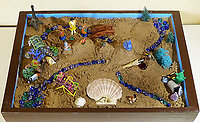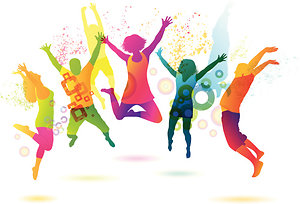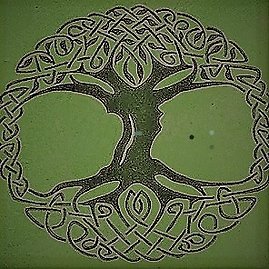What is Creative Arts Therapy ?
Creative Arts Therapies include dramatherapy, music therapy, art therapy, dance movement therapy, and integrative therapy which combines elements of all approaches.
What all Arts Therapies have in common is that in sessions, the client, supported by the therapist, uses an art form to explore and express feelings and experiences. My training is as a dramatherapist but I also integrate various other creative methods and a number of other therapeutic approaches into my work.
About Dramatherapy
If you have ever had strong emotions or identified with a character when you have been watching TV, a film or play, then you have experienced the power that drama, something imaginary, can have in reflecting real aspects of our lives, and what it means to be human. Drama can help us think about our lives, understand how we see ourselves, the roles that we play and our relationships, to make sense of things and make better choices.
So dramatherapy uses drama processes in a therapeutic way. That is to say it makes use of the imaginary and creative to reflect on the real. To find out more about Dramatherapy just click here to visit the British Association of Dramatherapists (B.A.D.T.H).
Understandably people sometimes assume that dramatherapy is all about acting. In actual fact dramatherapists draw on a variety of creative arts approaches in their work to suit each client, which may never include enactment.
I use the term Creative Arts therapy as it reflects this multi modal approach and the way I work.
For example a client may chose some miniature figures and objects to make an image in a sand tray. They may then go on to create a story about these figures, which indirectly represents some of the themes and struggles in their own lives. Or we might work with a myth or existing story that has themes that are relevant to the client’s situation. We could then make masks depicting characters in the story which may then be used for enactment.
These are just some possible ways of working. Others ways might include drawing, painting, using clay or collage to create images, writing, movement, using musical instruments or voice.
Using creativity in this way can be a helpful indirect and symbolic way for people to explore thoughts, feeling and experiences. This indirect approach can make it easier for a client to explore difficult issues and to better understand aspects of their experience by revealing new perspectives and meaning. This can be especially helpful to those with a history of trauma. By facilitating people to represent and express feelings about painful experiences that may be too distressing to talk about directly or ‘beyond words’, it can enable them to gradually heal the impact of their traumatic experiences on their lives, and to find ways of managing their lives differently.
The way I work with each person, and the methods we use, will be unique to you and your needs. You will not be asked to do anything you don't want to do and you will be able to choose what feels right for you.
So dramatherapy uses drama processes in a therapeutic way. That is to say it makes use of the imaginary and creative to reflect on the real. To find out more about Dramatherapy just click here to visit the British Association of Dramatherapists (B.A.D.T.H).
Understandably people sometimes assume that dramatherapy is all about acting. In actual fact dramatherapists draw on a variety of creative arts approaches in their work to suit each client, which may never include enactment.
I use the term Creative Arts therapy as it reflects this multi modal approach and the way I work.
For example a client may chose some miniature figures and objects to make an image in a sand tray. They may then go on to create a story about these figures, which indirectly represents some of the themes and struggles in their own lives. Or we might work with a myth or existing story that has themes that are relevant to the client’s situation. We could then make masks depicting characters in the story which may then be used for enactment.
These are just some possible ways of working. Others ways might include drawing, painting, using clay or collage to create images, writing, movement, using musical instruments or voice.
Using creativity in this way can be a helpful indirect and symbolic way for people to explore thoughts, feeling and experiences. This indirect approach can make it easier for a client to explore difficult issues and to better understand aspects of their experience by revealing new perspectives and meaning. This can be especially helpful to those with a history of trauma. By facilitating people to represent and express feelings about painful experiences that may be too distressing to talk about directly or ‘beyond words’, it can enable them to gradually heal the impact of their traumatic experiences on their lives, and to find ways of managing their lives differently.
The way I work with each person, and the methods we use, will be unique to you and your needs. You will not be asked to do anything you don't want to do and you will be able to choose what feels right for you.
How Creative Arts Therapy can help
On the journey of life that we all make there are many different stages and we travel through many different landscapes.
At times we may feel we’re at the beginning of a long climb up a mountain or alternatively feel life is taking us on a downward slope. At other times we may feel that we’ve come to a halt half way up a mountain, or as if we’re marooned on a shore when we want to set sail. Or it may feel like after a long hike we’ve reached a crossroads and are really unsure which road to take.
Whatever stage we are on our journey there may be a feeling of being stuck, exhausted or blocked in some way. Maybe it feels like we’re carrying a backpack that is too heavy, weighing us down, or, we simply don't have the right equipment or resources to help us keep going.
Exploring our experiences creatively and engaging our imaginations, our senses, our bodies and our emotions can help us start understanding some of what may be blocking us, or weighing us down, preventing us knowing what resources we already have, and what else we might need in order to continue the journey in the way we want or at least a way that feels possible.
Essentially Creative Arts therapy is a form of playfulness which is how as children we all develop,and learn to understand ourselves and others, and the world around, us. A creative arts approach helps us access our imagination and reconnect to this fundamental re-source .In this way we are better able to tap into our intuition and build strength and resilience from the inside, so we have what we need in our backpacks, and are better able to live to our full potential on the outside.
Engaging in creative activities in this sense is not about making ‘art’ or performing, but about exploring, and discovering new aspects of ourselves. It can help people to develop confidence in themselves, increase spontaneity willingness to imagine new possibilities and to try new things.
Whatever the focus of the work in ,i> Creative Arts therapy the very experience of working creatively, discovering spontaneity and playfulness can be both energising and freeing, leading people to a different experience of themselves, and giving them new resources for future growth and well-being.
You may find the following link about Creative Arts Therapies useful:
Just click here to visit Counselling Directory
At times we may feel we’re at the beginning of a long climb up a mountain or alternatively feel life is taking us on a downward slope. At other times we may feel that we’ve come to a halt half way up a mountain, or as if we’re marooned on a shore when we want to set sail. Or it may feel like after a long hike we’ve reached a crossroads and are really unsure which road to take.
Whatever stage we are on our journey there may be a feeling of being stuck, exhausted or blocked in some way. Maybe it feels like we’re carrying a backpack that is too heavy, weighing us down, or, we simply don't have the right equipment or resources to help us keep going.
Exploring our experiences creatively and engaging our imaginations, our senses, our bodies and our emotions can help us start understanding some of what may be blocking us, or weighing us down, preventing us knowing what resources we already have, and what else we might need in order to continue the journey in the way we want or at least a way that feels possible.
Essentially Creative Arts therapy is a form of playfulness which is how as children we all develop,and learn to understand ourselves and others, and the world around, us. A creative arts approach helps us access our imagination and reconnect to this fundamental re-source .In this way we are better able to tap into our intuition and build strength and resilience from the inside, so we have what we need in our backpacks, and are better able to live to our full potential on the outside.
Engaging in creative activities in this sense is not about making ‘art’ or performing, but about exploring, and discovering new aspects of ourselves. It can help people to develop confidence in themselves, increase spontaneity willingness to imagine new possibilities and to try new things.
Whatever the focus of the work in ,i> Creative Arts therapy the very experience of working creatively, discovering spontaneity and playfulness can be both energising and freeing, leading people to a different experience of themselves, and giving them new resources for future growth and well-being.
You may find the following link about Creative Arts Therapies useful:
Just click here to visit Counselling Directory
Where is Creative Arts Therapy Used?
Creative Arts therapists work in private practice with a wide range of people from all walks of life.
They are also employed in other areas such as the NHS where they may work with people with Mental Health difficulties or Learning disabilities in hospitals or in the community, or in hospices. They may also work in other settings such as prisons, colleges, or with older people or people with disabilities in day care or residential and nursing homes.
Creative Arts therapists also work in mainstream and special schools with children experiencing social, emotional and behavioural difficulties and with children and young people in organisations like CAMHS (Child and Adolescent Mental Health Services).
They may work in different community settings and charitable organisations with specific groups for example: women who have experienced domestic violence and abuse, people with sensory difficulties, groups experiencing discrimination such as members of the LGBT or BMI communities, people who are homeless, refugee groups etc.
The approach to work will depend on the needs of the individual or group and can be tailored to focus on specific themes eg: building self- esteem and social skills for people who have been unemployed and want to start working again; with older people with dementia using a multi-sensory approach encouraging communication and providing an enriching experience which can improve their "quality" of life; working with trauma survivors to process their traumatic experiences in a safe and supported environment and an opportunity to develop a new sense of themselves, empowering them to reclaim their lives.
Or there will be a more general focus enabling the individual or group to explore issues and themes of importance to them.
Creative Arts Therapies can also be adapted to training and personal development situations for eg: within Staff training and development programmes as a tool to explore staff well-being, teamwork, professional values, communication issues and developing an organisational vision.
Creative Arts Therapists have to be registered with the Health Care and Professionals Council (HCPC) the UK Regulatory body for what are known as Allied Health Professions. They abide by the code of conduct of the HCPC and have guidelines concerning supervision, continuous professional development and managing risk. Just click click here to visit HCPC.
They are also employed in other areas such as the NHS where they may work with people with Mental Health difficulties or Learning disabilities in hospitals or in the community, or in hospices. They may also work in other settings such as prisons, colleges, or with older people or people with disabilities in day care or residential and nursing homes.
Creative Arts therapists also work in mainstream and special schools with children experiencing social, emotional and behavioural difficulties and with children and young people in organisations like CAMHS (Child and Adolescent Mental Health Services).
They may work in different community settings and charitable organisations with specific groups for example: women who have experienced domestic violence and abuse, people with sensory difficulties, groups experiencing discrimination such as members of the LGBT or BMI communities, people who are homeless, refugee groups etc.
The approach to work will depend on the needs of the individual or group and can be tailored to focus on specific themes eg: building self- esteem and social skills for people who have been unemployed and want to start working again; with older people with dementia using a multi-sensory approach encouraging communication and providing an enriching experience which can improve their "quality" of life; working with trauma survivors to process their traumatic experiences in a safe and supported environment and an opportunity to develop a new sense of themselves, empowering them to reclaim their lives.
Or there will be a more general focus enabling the individual or group to explore issues and themes of importance to them.
Creative Arts Therapies can also be adapted to training and personal development situations for eg: within Staff training and development programmes as a tool to explore staff well-being, teamwork, professional values, communication issues and developing an organisational vision.
Creative Arts Therapists have to be registered with the Health Care and Professionals Council (HCPC) the UK Regulatory body for what are known as Allied Health Professions. They abide by the code of conduct of the HCPC and have guidelines concerning supervision, continuous professional development and managing risk. Just click click here to visit HCPC.




